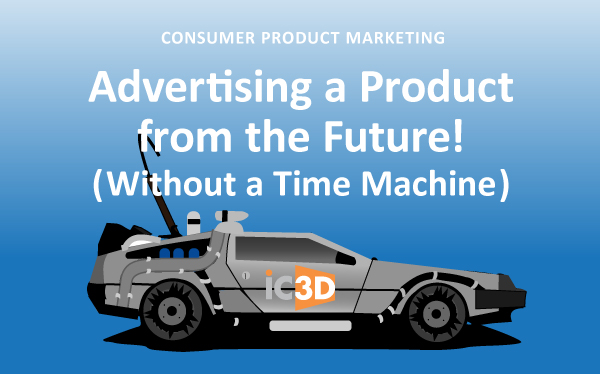Consumer Product Companies are a high-pressure business. Audience attention spans—always a finite thing—are shortening with every new media trend. Brand loyalty is ever harder to win. The 60-second TV ad and the glossy magazine spread are being replaced by media that are shorter, more frequent, and more subliminal than ever. New products have it worse than established brands. Designers and marketers have a serious challenge: advertising a product from the future—creating artwork for something that hasn’t been manufactured yet.
This isn’t a new challenge. Back in the day, if an ad campaign called for a product shot and the product didn’t exist yet, minions like me would spend hours constructing a realistic prototype. A good photographer or video specialist could make it work. Sure, and cost a lot of money, but those were the days of big ad budgets and expense accounts. Right?
The Digital Fix (Sort Of)
Digital retouch and Photoshop changed all that—or at least that’s what we thought. A good digital artist could create a realistic facsimile of the new product, and drop it into an ad.
Actually, it wasn’t Nirvanna. The cost of digital prototyping was still very high. Good digital artists commanded high wages, even with competition from low-cost, offshore facilities. The biggest cost of course was time. Creating a photorealistic image is not something done overnight. Also, keep in mind that Photoshop and Illustrator can only create one view at a time. If the art director changed his or her mind, then multiple versions of a future package would have to be created.
What About 3D?
For digital art of a future product, you’d think that 3D modeling or CAD software would be the answer. Unfortunately, until now, these programs didn’t meet the high visual standards for visual advertising. Even with sophisticated packaging software—often requiring many hours of render time—the finished results would have to be retouched in Photoshop before they could be used in an ad.
 Fortunately, that has changed. The next version of iC3D is adding ray tracing to its already formidable array of real-time design features. In this case, a picture is worth a thousand words.
Fortunately, that has changed. The next version of iC3D is adding ray tracing to its already formidable array of real-time design features. In this case, a picture is worth a thousand words.
The image shown here is of a product that does not exist—as an actual, physical object. The bottle and carton are ray-traced versions of iC3D packaging models. Now, in addition to real-time rendering for the review and approval process, the software now serves the marketing department’s need for advertising artwork. Ray tracing does require a short render time, but it cuts many hours and dollars from the process.
We’ll be showing off this new technology at Drupa Innovation Parc, in Düsseldorf, Germany, beginning on May 31. We hope to see you there (Stand C-16). If you can’t make it, of course we’d be happy to give you an online demo.
With iC3D, you can cut out huge amounts of time and expense to get ad-ready artwork of products that don’t even exist yet. Time Machine definitely not required.






